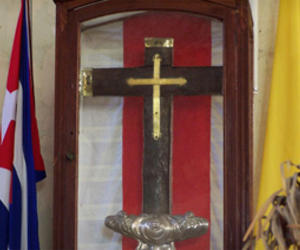Columbus' Cross Made Cuban National Monument
- Submitted by: manso
- Travel and Tourism
- 08 / 28 / 2011

Archbishop Points to History as Lesson for Future. By Araceli Cantero. BARACOA, Cuba, AUG. 26, 2011 (Zenit.org).- At the end of a thanksgiving Mass on Aug. 15, the archbishop of Santiago, Cuba, raised high the Cross of Parra, planted by Christopher Columbus on Dec. 1, 1492, and with it he blessed some 2,000 faithful gathered in the square.
Minutes earlier, the crowd broke out in applause on learning that the National Cuban Commission of Monuments declared the Cross of Parra a national monument. This cross is kept in the parish church of Our Lady of the Assumption in Baracoa.
Historian Eusebio Leal made the announcement and described the Eucharist in Baracoa as "a celebration of concord, a beautiful celebration for and in our homeland, in the oldest of all the cities of Cuba."
Bishop Wilfredo Pino Estévez of Guantanamo-Baracoa began the ceremony, welcoming the bishops of the island and government officials.
The Eucharist was presided over by Archbishop Dionisio Guillermo García Ibáñez of Santiago de Cuba, who preached the homily, inviting his listeners to live history as a teaching with a view to the future.
Catholics arrived from all the communities of the diocese wearing white T-shirts with the message: "500 generations of faith, 1511-2011, I saw a new heaven and a new earth."
At the beginning of the ceremony, young people gave a presentation on the origins of the city, the arrival of the first Spaniards, the meeting of cultures, and the evangelizing work of the missionaries, outstanding among whom was St. Anthony Mary Claret, bishop of Santiago de Cuba between 1849 and 1858, when the diocese covered virtually half the island.
The Havana historian spoke of Fray Bartolomé de las Casas, and Antonio de Montesinos, "who raised his voice for the Indians, for the aborigines, in Hispaniola Island and, particularly, in Santo Domingo." He recalled that the great Cuban poet José Martí described the missionary "as the apostle of the Indians," and described Fray De las Casas as "one of the authors of modern humanism, who was able to discuss in the debate of Valladolid the existence of an immortal soul in the aborigines."
Referring to the Cross of Parra, Leal explained how the National Commission of Monuments did an analysis to verify its historicity.
He also noted that some days before, President Raúl Castro presented the topic of faith "as a cardinal topic of liberty."
The historian said that that address "was as important for us as the Edict of Milan," by which Emperor Constantine in the fourth century allowed Christians to practice their faith freely: "The right of all those that today, for reasons of love of history or out of devotion, recognize in that Cross a part of their people."
Baracoa is the primate city of the Caribbean country and the first visited by Christopher Columbus in Cuba, on Nov. 27, 1492, as he himself attested in his diary. The Diocese of Guantanamo-Baracoa was erected by John Paul II during his visit to Cuba in January of 1998.
Source: www.zenit.org/article-33297?l=english
Comments